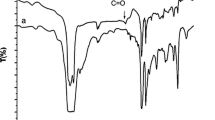Abstract
Selectively epoxidized trans-1,4-polyisoprene (SETPI) and randomly epoxidized trans-1,4-polyisoprene (RETPI) were fabricated successfully through modified surface water-phase suspension epoxidation and solution random epoxidation, respectively. The effects of fabricated method and epoxy degree of ETPI on the glass transition temperature (T g), dynamic mechanical properties and phase separation phenomenon of the as-fabricated polymer have been investigated by different scanning calorimetry, dynamic mechanical analyzer and phase contrast microscope. The double bonds and epoxy groups sequence structure distribution of different ETPI have been observed and analyzed by 13C-NMR. There is a great deal of difference in the microstructure and sequence distribution of epoxy group in ETPI with different synthesis methods and epoxy degree. The results show that distribution of epoxy group in SETPI is nonuniform which brings about the phase separation.






Similar content being viewed by others
References
Song JS, Huang BC, Yu DS (2001) Progress of synthesis and application of trans-1,4-polyisoprene. J Appl Polym Sci 82(1):81–89
Gemmer RV, Golub MA (1978) C-NMR spectroscopic study of epoxidized-1,4-polyisoprene and -1,4-polybutadiene. J Polym Sci 16:2985–2990
Zemel IS, Corrigan JP, Woodward AE (1989) Crystallization of segmented trans-1,4-polyisoprene/epoxidized trans-1,4-polyisoprene block copolymers from solution. J Polym Sci B Polym Phys 27:2479–2492
Burfield DR, Eng A-H (1989) Glass transition and crystallization phenomena in epoxidized trans-1,4-polyisoprene: a differential scanning calorimetry study. Polymer 30(11):2019–2022
Nadarajah V (1994) Thermal studies of solution epoxidized trans-1,4-polyisoprene. Polym J 26(11):1291–1294
Akihiro S, Ichiro T, Kazuhiro N (2011) Epoxidized trans-polyisoprene giving high-toughness and hardness resins. JP 2011037960 A 20110224
Zhao YX, Huang BC, Yao W, Cong HL, Shao HF, Du AH (2008) Epoxidation of high trans-1,4-polyisoprene and its properties. J Appl Polym Sci 107(5):2986–2993
Shao HF, Zhang MM, Xiao P, Yao W, Huang BC (2012) Study on the viscoelastic property of the epoxidized trans-1,4-polyisoprene by rubber process analyzer. Polym Sci 54(8):1–7
Osamu H, Tooru T, Hideo K, Haruo U (1981) Monomer unit sequence distribution in partly epoxidized trans-1,4-polyisoprene. Polymer 3(3):215–223
Nadarajah V, Joseph PC, Woodward AE (1994) Bulk crystallization of solution epoxidized trans-1,4-polyisoprene. Macromol Chem Phys 195:2435–2443
Schilling FC, Bovey FA, Anandakumaran K, Woodward AE (1985) Quantitative measurement of chain folding in 1,4-trans-polyisoprene crystals by carbon-13 NMR spectroscopy. Macromolecules 18:2688–2695
Acknowledgments
Appreciation is expressed to NSFC No. 51273100, Natural Science Fund for Distinguished Young Scholars of Shandong Province (JQ201213).
Author information
Authors and Affiliations
Corresponding authors
Rights and permissions
About this article
Cite this article
Shao, H., Wang, C., Xiao, P. et al. Observation of phase separation of epoxidized trans-1,4-polyisoprene and mechanism exploration through 13C-NMR. Polym. Bull. 70, 2211–2221 (2013). https://doi.org/10.1007/s00289-013-0939-7
Received:
Revised:
Accepted:
Published:
Issue Date:
DOI: https://doi.org/10.1007/s00289-013-0939-7



